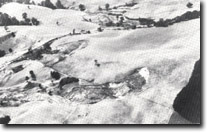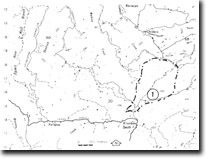1. Landslips - Dingley Dell, Childers
Mass movement processes in the South Gippsland Hills - Landslips and Soil Creep
This information has been developed from the publications:
|
| Location: | 215558, 235555, 238577. Valley of Elizabeth Creek between Childers and Allambee South. |  Rotational slump and earthflow - Watkins Creek near Allambee South. |
Access: | McDonalds Track, Dingley Dell Road. | |
Ownership: | Private land. | |
Geology/Geomorphology: | Childers formation sediments lie unconformably on Mesozoic arkose and mudstone and are overlain by the Thorpdale Volcanics. The Childers Formation consist of siliceous conglomerate, quartzite, gravel, sand and clay and is generally poorly consolidated. Deep weathering has produced montmorillonitic clays in the Thorpdale Volcanics and mass movements involving the Childers Formation sediments and the weathered basalts are common. The movements are of a complex nature. Rotational slumps produce steep headwall scarps and on the steeper slopes, the slumped material often becomes severely deformed as more rapid flow movement taken place. | |
Significance: | State. The slumps are a major process of slope development on the area adjacent to the Thorpdale Volcanics. They illustrate clearly the contribution of geology to slope formation as the major slumps occur in areas where unconsolidated or weathered materials overly more resistant rocks. This factor is very evident here, particularly when compared with slopes developed entirely on Thorpdale Volcanics to the north-east (Thorpdale and Narracan). | |
Management: | Detailed analysis of slope stability is necessary in areas where there is evidence of prior landslide activity or where Childers Formation outcrops underneath the basalt. The existing landslides are important sites to demonstrate the rates and processes of mass movement. Extensive slope reclamation schemes should not be carried out unless substantial risk to property is involved. | |
 Rotational slumps and complex earthflows - Dingley Dell. |



